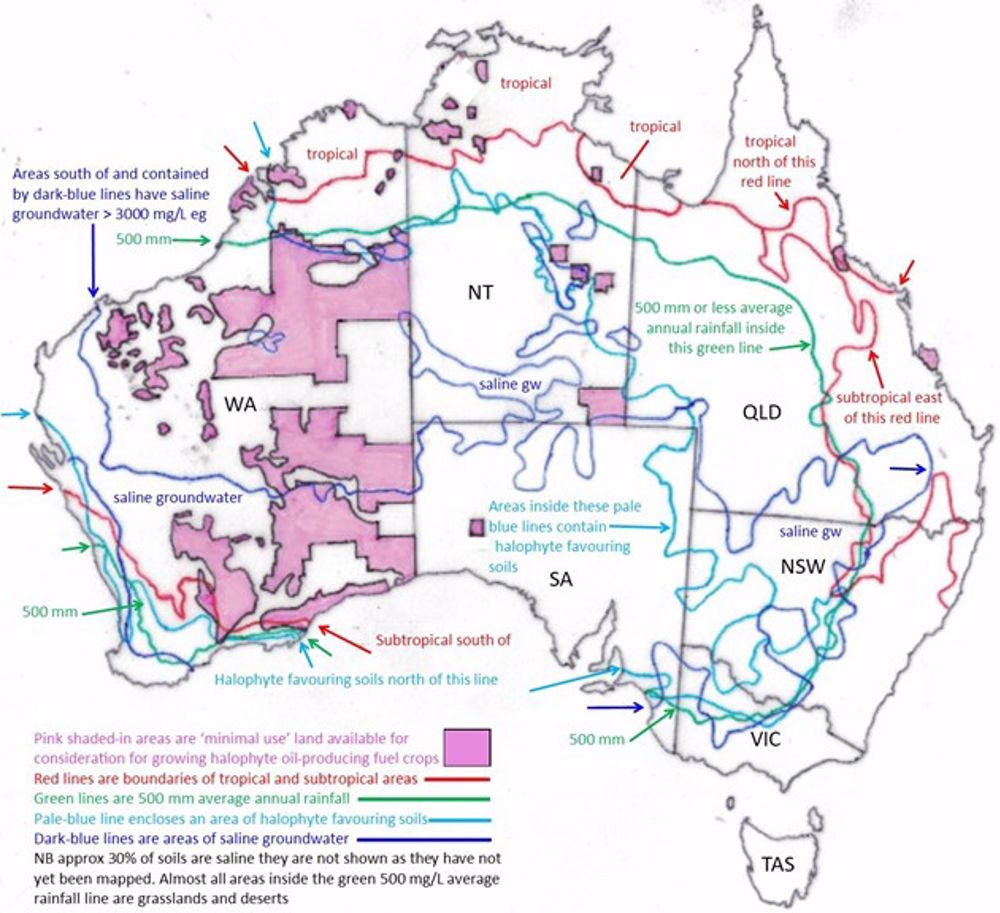The Future Bioenergy Potential of Australia
Introduction
I am an experienced chemical, environmental and risk engineer. While completing a PhD in applied science in 2019, I investigated the possibility of replacing fossil fuels with vegetable oil (VO). This has potential to be sustainable by being greenhouse-gas neutral and has the added benefit of much improving fuel safety. Firstly I conducted a literature review studying engines, oil producing plant species and land availability for growing fuels. Engines addressed were the various forms of compression-ignition engine including Herbert Ackroyd Stuart’s oil engine, Rudolf Karl Diesel’s diesel engine and Ludwig Elsbett’s modified diesel engine designed specifically for vegetable oil. I then drove my 1996 Mitsubishi Triton utility vehicle for a total of 45,000km under trial conditions involving town and country travel, noting weather and traffic conditions, vehicle loading and fuel type. Fuel was initially straight vegetable oil (SVO) but following some difficulties I switched to a 50/50 blend of VO and diesel fuel, using straight diesel fuel as control.
Other researchers used blends with typically 2-10% vegetable oil and almost exclusively used food oils. Using these we would effectively be taking food out of people’s mouths. There was almost no other work done in Australia and limited on-road trials anywhere in the world, researchers usually working in the laboratory with single-cylinder test engines. Even less work was available using fuel from oil-producing trees such as Indian Beech, Sea Almond, Indian Lilac and Mastwood. My work used filtered waste vegetable oil from a number of local fish-and-chip shops.
I concluded (a) that the 50/50 vegetable oil/diesel fuel blend is viable and performed slightly better than diesel fuel, (b) that there are more than 2000 species of non-food oil producing plants and trees available, and (c) that there is nowhere near enough land available to provide current world energy consumption unless we move towards sustainable populations and economies. The latter problem led me to address the broader sociological and philosophical questions posed by our current use of fossil fuels such as land-grabbing in poorer countries to satisfy the fuel and food needs of wealthier nations and the economic and environmental pressure which our continuing near-exponential population growth causes.
The dearth of work in Australia led me to consider the potential for growing and processing vegetable oil producing crops here. I quickly homed-in on salt loving species known as halophytes because there are so many species available, they are salt tolerant and do not need to use agricultural land.
Once I realised that non-food vegetable oil works, I then assessed the ability of Australia to produce this novel fuel, in some detail.
The future bioenergy potential of Australia
Australia has an area of 7.7 million km2 a large part of which comprises little-used arid and semi-arid land. The country in world terms has a very stable government and is the sixth largest singly-managed land mass. It is one of the least populated and least cultivated land-masses in the world and therefore has the greatest area of land available for potential other uses (74.9%). Much of mainland Australia contains naturally saline soils and cleared cropped areas are prone to anthropogenically caused secondary salinisation. Coastal areas are prone to acid sulphate soil presence. Outer rim agricultural land is at greatest risk of anthropogenic salinity. The central inland is substantially free of human-caused salinity largely because our activity here is minimal. By far the most suitable species for oil fuel production steering clear of food oil species, are the salt-tolerant or salt-loving plant and tree species known as halophytes. Many grow naturally in Australia and are capable of surviving in desert conditions. They can also be used to progressively reclaim the current 57,000km2 of salt-affected agricultural lands which otherwise is predicted to reach from 170,000 to 300,000 km2 by 2050. By careful selection of plant species and use of saline/sodic borewater and seawater irrigation, I have found that a significant area could be set aside to crops in particular, to sustainable fuel crops. Halophyte propagation does not need irrigation but production would increase by using saline/sodic borewater and reticulated seawater.
I describe current sustainable fuel initiatives such as trial propagation of Indian Beech tree and Agave plants in the northern tropics and of speargrass, bluegrass, brigalow and buffel grass in the Burdekin and Fitzroy River catchment areas. I also address current production of biofuels, hydroelectricity, solar-voltaic power and wind power as well as the potential for using safe nuclear power in the future. Empire Biofuels Australia plans to construct a factory to process biomass into ethanol using Giant Reed (Arundo donax) grown on a 40,000 Ha semi-desert site in Western Australia based on research and practice in other countries such as South Africa and Italy. My work has been examined by a researcher in Argentina where there are equally extensive possibilities for producing halophyte oil-producing plant and tree crops. I conclude that Australia has the potential to become one of the world’s largest producers and exporters of halophyte-based biofuels.
In this work I have considered climate, soil type, groundwater availability, coastal proximity, soil salinity, soil sodicity, dryland salinity risk, urban area salinity risk, the presence of protected areas, other land uses and precedents created by Argentina and Abu Dhabi. It shows that 6.5% of the country comprising 499,687 km2 of land is available for halophyte vegetable oil fuel production. This appraisal is conservative in that it does not include tropical areas where tree oil-producing species such as Indian Beech (Milletia pinnata), Mastwood (Calophyllum inophyllum), Drumstick (Moringa oleifera) and Castor Oil (Ricinus communis) trees could be considered. Based solely upon the propagation of halophyte ground crops and trees in arid and semi-arid areas, an estimated 6.5% of the country (500,000km2) is available without encroaching on other land uses. A map showing these areas is presented at Figure 1.
